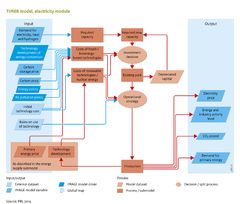Energy conversion/Data uncertainties limitations: Difference between revisions
Jump to navigation
Jump to search
No edit summary |
No edit summary |
||
| Line 53: | Line 53: | ||
</div> | </div> | ||
===Uncertainties=== | |||
<div class="version changev31"> | <div class="version changev31"> | ||
The two main uncertainties are calculation of future energy conversion relating to development rates of the conversion technologies, and the consequences for the electricity system of a high level of market penetration of renewable energy. | The two main uncertainties are calculation of future energy conversion relating to development rates of the conversion technologies, and the consequences for the electricity system of a high level of market penetration of renewable energy. | ||
TIMER electric power generation submodule has been tested for different levels of market penetration of renewable energy ([[De Boer and Van Vuuren, under review]]; [[Pietzcker et al., under review]]; [[Luderer et al., in preparation]]). The model was shown to reproduce the behaviour of more detailed models that describe electricity system developments. | TIMER electric power generation submodule has been tested for different levels of market penetration of renewable energy ([[De Boer and Van Vuuren, under review]]; [[Pietzcker et al., under review]]; [[Luderer et al., in preparation]]). The model was shown to reproduce the behaviour of more detailed models that describe electricity system developments. | ||
| Line 60: | Line 60: | ||
===Limitations=== | ===Limitations=== | ||
The model describes long-term trends in the energy system, which implies that the focus is on aggregated factors that may determine future energy demand and supply. However in energy conversion, many short-term dynamics can be critical for the system, such as system reliability and ability to respond to demand fluctuations. These processes can only be represented in an aggregated global model in terms of meta-formulations, which implies that some of the integration issues regarding renewable energy are still not addressed. | <div class="version changev31"> | ||
The model describes long-term trends in the energy system, which implies that the focus is on aggregated factors that may determine future energy demand and supply. However in energy conversion, many short-term dynamics can be critical for the system, such as system reliability and ability to respond to demand fluctuations. These processes can only be represented in an aggregated global model in terms of meta-formulations, which implies that some of the integration issues regarding renewable energy are still not addressed. A more detailed discussion on the model limitations can be found in De Boer and Van Vuuren ([[De Boer and Van Vuuren, under review|under review]]). | |||
</div> | |||
Another limitation is the formulation of primary fossil-fuel conversions in secondary fuels. TIMER currently does not include a module that explicitly describes these processes. | Another limitation is the formulation of primary fossil-fuel conversions in secondary fuels. TIMER currently does not include a module that explicitly describes these processes. | ||
}} | }} | ||
Revision as of 13:34, 11 November 2016
Parts of Energy conversion/Data uncertainties limitations
| Component is implemented in: |
|
| Related IMAGE components |
| Projects/Applications |
| Models/Databases |
| Key publications |
| References |
